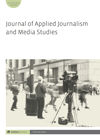
Full text loading...
 , José Manuel Pérez Tornero2
, José Manuel Pérez Tornero2
Artificial Intelligence (AI) is being introduced to news routines. There is a need for theoretical framework to instruct the AI-adopting process and better integrate the cross-domain knowledge. This article attempts to explicate the major transformations AI brings to news systems, i.e., automated writing and personalization at scale. In light of the transformations, the tension between AI and human journalists has drawn attention. In order to unravel the accompanied conundrums, we propound a new notion – AI journalism, which is a trans-domain field of various categories, deriving from journalism automation. We propose to build AI journalism ontology that can manifest the emerging phenomenon in news ecosystem where intelligent machines and human journalists are coexisting. This article’s ultimate contribution is proffering a new framework and a transdisciplinary field to examine the integration of AI and associated technologies into journalism.

Article metrics loading...

Full text loading...
References


Data & Media loading...

Publication Date:
https://doi.org/10.1386/ajms_00063_1 Published content will be available immediately after check-out or when it is released in case of a pre-order. Please make sure to be logged in to see all available purchase options.